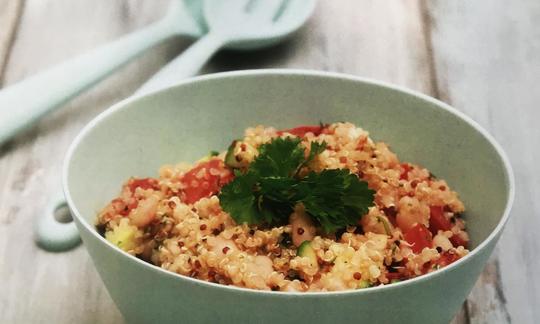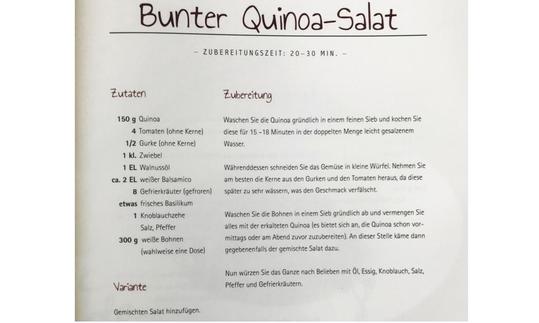Colorful Quinoa Salad with Herbs and White Beans
vegan
Ingredients (for servings, )
| For the salad | |
|---|---|
| 5 ½ oz | Quinoa, raw, peeled (organic?) |
| 1 small | Onions, raw (organic?) (1.6 oz) |
| 1 clove | Garlic (organic?) (0.11 oz) |
| 4 | Tomatoes, raw (organic?) (17 oz) |
| ½ | Cucumbers, raw (organic?) (8.1 oz) |
| 11 oz | Beans, white, cooked, without salt (Alubia) |
| For the dressing | |
| 6 leaves | Basil, fresh (organic?) (0.11 oz) |
| 1 tbsp | Parsley, fresh, raw (leaf parsley, parsley) (0.13 oz) |
| ½ tbsp | Walnut oil (cold pressed?, raw?, organic?) (0.24 oz) |
| ½ tbsp | Linseed oil (linseed oil, flax oil), cold pressed (raw?, organic?) (0.24 oz) |
| 2 tbsp | Balsamic vinegar, white (Condimento bianco, organic?, raw?) (1.1 oz) |
| 1 dash | Table salt (table salt, raw?, organic?) (0.01 oz) |
| 1 dash | Black pepper (organic?, raw?) (0.00 oz) |
Equipment
- garlic press
- stove
- saucepan
- sieve
- Dosenöffner
Type of preparation
- cook
- chop or grind
- soak
- squeeze
- strain
- remove the skin
Preparation
Preparation of the Quinoa Salad
Wash the quinoa thoroughly in a fine sieve and cook it for 15-18 minutes in twice the amount of lightly salted water.It is a good idea to prepare the quinoa in the morning or the evening before.
Meanwhile, peel the onion and garlic, wash the tomatoes and cucumber. Cut the onion, tomatoes and cucumber into small cubes. Press the garlic.
It is best to remove the seeds from the cucumbers and tomatoes, as they will later become too watery, which will distort the taste.
Wash the beans thoroughly in a sieve. Mix the beans, tomatoes, cucumber, onion and garlic with the cooled quinoa.
Prepare beans yourself: Instead of using ready-made beans from a can, you can also prepare beans yourself (see alternative preparation).
Mixed Salad: An optional variation of this recipe involves adding mixed salad at this stage.
For the dressing
Wash herbs and chop finely. Add herbs, oil, vinegar, salt and pepper to taste, to the quinoa salad and mix.In the original, Anke Lüßenhop uses "frozen herbs". If you have fresh herbs available, these are preferable.
The only oil used in the original recipe is walnut oil. We reduced the amount of walnut oil by half and replaced the other half with linseed oil (see notes).
|
Nutritional Information per person
Convert per 100g
|
2000 kcal | |
|---|---|---|
| Energy | 254 kcal | 12.7% |
| Fat/Lipids | 5.6 g | 7.9% |
| Saturated Fats | 0.66 g | 3.3% |
| Carbohydrates (inc.dietary fiber) | 42 g | 15.5% |
| Sugars | 7.1 g | 7.9% |
| Fiber | 9.4 g | 37.6% |
| Protein/Albumin | 11 g | 22.5% |
| Cooking Salt (Na:54.3 mg) | 138 mg | 5.7% |
| Essential micronutrients with the highest proportions | per person | 2000 kcal | |
|---|---|---|---|
| Vit | Folate, as the active form of folic acid (née vitamin B9 and | 135 µg | 67.0% |
| Fat | Alpha-Linolenic acid; ALA; 18:3 omega-3 | 1.2 g | 61.0% |
| Min | Manganese, Mn | 1.1 mg | 54.0% |
| Prot | Tryptophan (Trp, W) | 0.13 g | 51.0% |
| Min | Copper, Cu | 0.44 mg | 44.0% |
| Prot | Threonine (Thr, T) | 0.41 g | 44.0% |
| Elem | Phosphorus, P | 286 mg | 41.0% |
| Elem | Potassium, K | 825 mg | 41.0% |
| Prot | Lysine (Lys, K) | 0.67 g | 36.0% |
| Vit | Vitamin K | 27 µg | 36.0% |
Detailed Nutritional Information per Person for this Recipe
The majority of the nutritional information comes from the USDA (US Department of Agriculture). This means that the information for natural products is often incomplete or only given within broader categories, whereas in most cases products made from these have more complete information displayed.
If we take flaxseed, for example, the important essential amino acid ALA (omega-3) is only included in an overarching category whereas for flaxseed oil ALA is listed specifically. In time, we will be able to change this, but it will require a lot of work. An “i” appears behind ingredients that have been adjusted and an explanation appears when you hover over this symbol.
For Erb Muesli, the original calculations resulted in 48 % of the daily requirement of ALA — but with the correction, we see that the muesli actually covers >100 % of the necessary recommendation for the omega-3 fatty acid ALA. Our goal is to eventually be able to compare the nutritional value of our recipes with those that are used in conventional western lifestyles.
| Essential fatty acids | per person | 2000 kcal |
|---|---|---|
| Alpha-Linolenic acid; ALA; 18:3 omega-3 | 1.2 g | 61.0% |
| Linoleic acid; LA; 18:2 omega-6 | 2.1 g | 21.0% |
| Essential amino acids | per person | 2000 kcal |
|---|---|---|
| Tryptophan (Trp, W) | 0.13 g | 51.0% |
| Threonine (Thr, T) | 0.41 g | 44.0% |
| Lysine (Lys, K) | 0.67 g | 36.0% |
| Isoleucine (Ile, I) | 0.43 g | 35.0% |
| Phenylalanine (Phe, F) | 0.53 g | 34.0% |
| Valine (Val, V) | 0.51 g | 32.0% |
| Leucine (Leu, L) | 0.75 g | 31.0% |
| Methionine (Met, M) | 0.18 g | 19.0% |
| Vitamins | per person | 2000 kcal |
|---|---|---|
| Folate, as the active form of folic acid (née vitamin B9 and | 135 µg | 67.0% |
| Vitamin K | 27 µg | 36.0% |
| Vitamin C (ascorbic acid) | 22 mg | 27.0% |
| Thiamine (vitamin B1) | 0.27 mg | 24.0% |
| Vitamin B6 (pyridoxine) | 0.33 mg | 23.0% |
| Riboflavin (vitamin B2) | 0.17 mg | 12.0% |
| Biotin (ex vitamin B7, H) | 5.4 µg | 11.0% |
| Niacin (née vitamin B3) | 1.6 mg | 10.0% |
| Vitamin E, as a-TEs | 1.2 mg | 10.0% |
| Pantothenic acid (vitamin B5) | 0.48 mg | 8.0% |
| Vitamin A, as RAE | 61 µg | 8.0% |
| Essential macroelements (macronutrients) | per person | 2000 kcal |
|---|---|---|
| Phosphorus, P | 286 mg | 41.0% |
| Potassium, K | 825 mg | 41.0% |
| Magnesium, Mg | 109 mg | 29.0% |
| Calcium, Ca | 92 mg | 11.0% |
| Sodium, Na | 54 mg | 7.0% |
| Essential trace elements (micronutrients) | per person | 2000 kcal |
|---|---|---|
| Manganese, Mn | 1.1 mg | 54.0% |
| Copper, Cu | 0.44 mg | 44.0% |
| Iron, Fe | 3.3 mg | 24.0% |
| Zinc, Zn | 1.8 mg | 18.0% |
| Selenium, Se | 5.5 µg | 10.0% |
| Iod, I (Jod, J) | 1.6 µg | 1.0% |
| Fluorine, F | 4.1 µg | < 0.1% |
You can vary the colorful quinoa salad with herbs and white beans as you wish.
Nutrient profile: According to GDA guidelines, one portion of this recipe covers approximately ¾ of the daily requirement of folic acid and 66% of the daily requirement of manganese. The omega-3 fatty acids are covered by over 60% and the essential amino acid tryptophan and the trace element copper by over 50%. The ratio of omega-6 to omega-3 fatty acids is 2:1, which is significantly below the recommended maximum ratio of 5:1.
Serving size: The indicated amount is sufficient for a main course of about 3-4 portions or for a side dish of 6 portions.
Quinoa: Quinoa is not a grain. The small Inca grain is a goosefoot plant and belongs to the same plant family as beetroot and spinach. The vitamin content and nutritional value is roughly comparable to that of rice. However, the protein content is higher and the pleasantly nutty quinoa contains a larger amount of polyunsaturated fatty acids (but fewer carbohydrates). Quinoa contains significantly more minerals and about twice as much iron and 50 percent more vitamin E than wheat.
Linseed oil: Also known as Linseed oil known as linseed oil comes from linseed, the ripe seeds of the common flax ( Linum usitatissimum). Fresh, cold-pressed linseed oil has a slightly distinctive taste, tastes slightly nutty and hay-like. It has a golden yellow color. Cold-pressed linseed oil is a good source of omega-3 fatty acids, but is sensitive to oxidation and can only be stored for a very short time. The ratio of linoleic acid (omega-6 fatty acid) to α-linolenic acid (omega-3 fatty acid) in linseed oil is approximately 1:3 - 1:4.
What do you have to pay attention to as a vegan?
You can find more information about the composition of this dish in the nutrient tables under the recipe preparation. Information on the optimal ratio of fatty acids and general information on common nutritional errors in vegan and raw diets can be found at the following link: Vegans often eat unhealthily. Avoidable nutritional errors .
Pre-cooked beans: White beans (like other beans and legumes) are usually dried or pre-cooked and preserved. While the preserved version is more convenient and saves time, the dried version has the advantage of tasting better. In addition, by cooking at home you can determine the degree of firmness yourself (canned beans are often very soft, sometimes even mushy). Of course, canned goods often contain unnecessary additives or are heavily salted, and the unprocessed version is therefore preferable. If you decide to buy ready-made beans, it is advisable to only buy organic canned goods. They are often processed more gently, but above all they contain fewer or no additives. Glass canned goods are particularly recommended, and are generally the most common in organic stores. These do not contain aluminum or BPA (bisphenol A) and are more environmentally friendly.
Nut allergy: If you have a nut allergy, you can omit the nuts and just use linseed oil for the salad.
Cooking white beans yourself: You should soak the beans well before cooking (preferably overnight) to reduce the phytic acid content. Phytic acid irreversibly binds minerals in the human body, so that they are no longer available to the organism. You can find out more about this in the following article:
Phytic acid or phytate and soaking or sprouting.
After soaking, rinse the beans well and cook with a little salt and just below boiling point.





